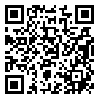Volume 24, Issue 6 (June 2024)
Modares Mechanical Engineering 2024, 24(6): 363-371 |
Back to browse issues page
Download citation:
BibTeX | RIS | EndNote | Medlars | ProCite | Reference Manager | RefWorks
Send citation to:



BibTeX | RIS | EndNote | Medlars | ProCite | Reference Manager | RefWorks
Send citation to:
Esrafili H R, Amirabadi H, Akbari J, Jafarian F. An Empirical Study on the Effect of Feed Rate and Cutting Depth on the Cutting Force, Chip Temperature, Surface Roughness, and Microhardness Variation in Laser-Assisted Turning Compared to Conventional Turning of Waspaloy. Modares Mechanical Engineering 2024; 24 (6) :363-371
URL: http://mme.modares.ac.ir/article-15-76234-en.html
URL: http://mme.modares.ac.ir/article-15-76234-en.html
1- University of Birjand
2- University of Neyshabur ,hamirabadi@neyshabur.ac.ir
3- Sharif University of Technology
4- Mahallat Institute of Higher Education
2- University of Neyshabur ,
3- Sharif University of Technology
4- Mahallat Institute of Higher Education
Abstract: (1058 Views)
The conventional material removal processes have always run into difficulties in machining hard materials, and nickel-based superalloys are no exception. The inherent properties of these materials usually lead to high tool wear rates and low surface integrity. These concerns justify the need for combining conventional material removal processes with advanced technologies. Laser Assisted Machining is one such process by which, through localized softening of work material prior to the cutting operation, a more efficient material removal process can be realized compared with what can be done by conventional machining. This work studies the effect of machining parameters such as constant Rotational speed at 400 RPM, feed rates of 0.035, 0.07, 0.105 mm/rev, and cutting depths of 0.3, 0.6, and 0.9 mm on variation of cutting force, chip temperature, surface roughness, and microhardness in variation of the workpiece surface. The process is a Laser Assisted Turning (LAT) process compared to conventional Turning (CT) by analyzing the parameters for a Waspaloy. A fiber laser with constant power output of 500 W was used to irradiate the tool material. The angle of contact of the beam with the tip of the tool was fixed at 60°. The workpiece's hardness was 385 ± 10 Vickers initially and had a diameter of 25 mm. It has been revealed that the application of LAT decreases the cutting force up to 16% compared to CT. The workpiece surfaces produced by LAT had higher chip temperatures than CT and were of 42% better quality in terms of surface roughness. In the LAT process, the difference in microhardness values at different points on the workpiece surface was within a much smaller range than in the CT process. The results showed that as the scanning speed of the laser increased on the surface of the workpiece, the thickness of the laser heat-affected zone below the surface of the workpiece decreased.
Keywords: Laser Assisted Machining (LAM), Cutting Forces, Surface Roughness, Chip Temperature, Microhardness
Article Type: Original Research |
Subject:
Machining
Received: 2024/07/23 | Accepted: 2024/08/30 | Published: 2024/05/30
Received: 2024/07/23 | Accepted: 2024/08/30 | Published: 2024/05/30
Send email to the article author
| Rights and permissions | |
 |
This work is licensed under a Creative Commons Attribution-NonCommercial 4.0 International License. |







